
Abandoned & Little-Known Airfields:
Western South Dakota
© 2002, © 2025 by Paul Freeman. Revised 3/12/25.
This site covers airfields in all 50 states: Click here for the site's main menu.
____________________________________________________
Please consider a financial contribution to support the continued growth & operation of this site.
Black Hills Army Airfield (revised 1/6/19) - Custer State Park Airport (added 3/12/25) - Eulberg Airfield (added 3/23/21) - Lien Airport (revised 7/30/15) - Mission Sioux Airport (added 3/19/21)
Newell Airport (revised 7/20/24) - Sturgis Municipal Airport (2nd location) (revised 8/28/16)
____________________________________________________
Custer State Park Airport (3V0), Custer, SD
43.725, -103.351 (South of Sturgis, SD)

Custer State Park Airport, as depicted on the June 1955 Casper Sectional Chart.
This airport on the grounds of Custer State Park was evidently established at some point between 1950-52,
as it was not yet depicted on the 1950 Casper Sectional Chart.
The earliest depiction which has been located of Custer State Park Airport was on a 1952 aerial photo,
which depicted a single unpaved northwest/southeast unpaved runway, with an adjacent segmented circle marking.
There were no aircraft on other improvements visible on the field.
The earliest aeronautical chart depiction which has been located of Custer State Park Airport was on the June 1955 Casper Sectional Chart.
It depicted Custer State Park Airport as as having a 2,900' unpaved runway.

The earliest topo map depiction which has been located of Custer State Park Airport was on the 1958 USGS topo map.
It depicted a single unpaved northwest/southeast unpaved runway, generically labeled “Landing Field”.

The 1978 USGS topo map depicted “Custer State Park Airstrip” as a single northwest/southeast runway.

The earliest photo which is available of Custer State Park Airport was a 1991 aerial view looking east.
The field had been improved at some point between 1952-91, with an asphalt runway & ramp, and a small hangar on the northwest side.
There were still no aircraft visible on the field.

The only photo which has been located showing planes at Custer State Park Airport was a 2015 aerial view,
which showed 2 light single-engine planes parked on the ramp.

The last aeronautical chart depiction which has been located of Custer State Park Airport was on the January 2020 Sectional Chart.
It depicted Custer State Park Airport as as having a single 4,000' paved northwest/southeast runway.

A circa2022 aerial view looking northeast showed the Custer State Park Airport remained intact.

A 2022 aerial view looking east showed the Custer State Park Airport remained intact.

A 2022 photo looking northwest along the Custer State Park Airport runway.

A 2022 photo looking west at the Custer State Park Airport ramp & hangar.
The Custer State Park Airport was closed in 2023.

A 2024 aerial view looking east showed the Custer State Park Airport runway pavement had been removed at some point between 2023-2024.
Thanks to Sebastian Nielsen for pointing out this airfield.
____________________________________________________
45.085, -101.55 (Northeast of Rapid City, SD)
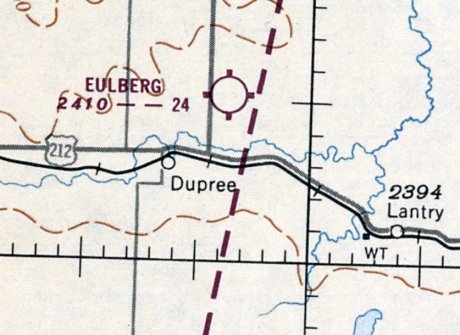
Eulberg Airfield, as depicted on the 1951 Aberdeen Sectional Chart.
Photo of the airport while in use has not been located.
According to Jonathan Westerling, “Eulberg Airfield was built in 1950 & run by local pilot Rollin Eulberg.
It was the first airport to serve the town of Dupree, county seat of Ziebach County.
According to his obituary in the Rapid City Journal, Rollin served as a paratrooper in the European Theater, and after the war he became a licensed commercial pilot.
In addition to farming, Rollin made brisk business in flying. Rollin soon began a 2-year partnership with Al McDonald, operating the E/M Flying Service out of Newell & Dupree.”
A 1950 airport directory (courtesy of Jonathan Westerling) listed “Dupree Airport” as a “new field” at the eventual location of Eulberg Airfield.
The earliest depiction which has been located of Eulberg Airfield was on the 1951 Aberdeen Sectional Chart.
It depicted Eulberg Airfield as having a 2,400' unpaved runway.
According to Jonathan Westerling, “For the next two decades, Rollin flew nearly 10,000 hours in 26 different types of aircraft.
Much of the flights were aerial spraying for local farmers. Rollin also often flew supplies to farms that were snowbound, carrying food, mail, kerosene and even cattle feed.
He also flew doctors to deliver babies, people to hospitals for treatment, and Santa Claus to the children of Dupree.”
Eulberg Airfield was not depicted on the 1953 USGS topo map.
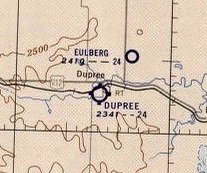
The last depiction which has been located of Eulberg Airfield was on the 1955 Aberdeen Sectional Chart.
It depicted Eulberg Airfield as having a 2,400' unpaved runway.
Note that it also depicted the new Dupree Municipal Airport to the southwest, which would presumably replace Eulberg Airport shortly.
A 1955 aerial photo did not show any recognizable trace of an airfield at the location of Eulberg Airfield.
According to Jonathan Westerling, “Eulberg Airfield was no longer depicted on the 1958 Aberdeen Sectional Chart.
Presumably Rollin moved his operations to the Municipal airfield which had been built a few years earlier.”
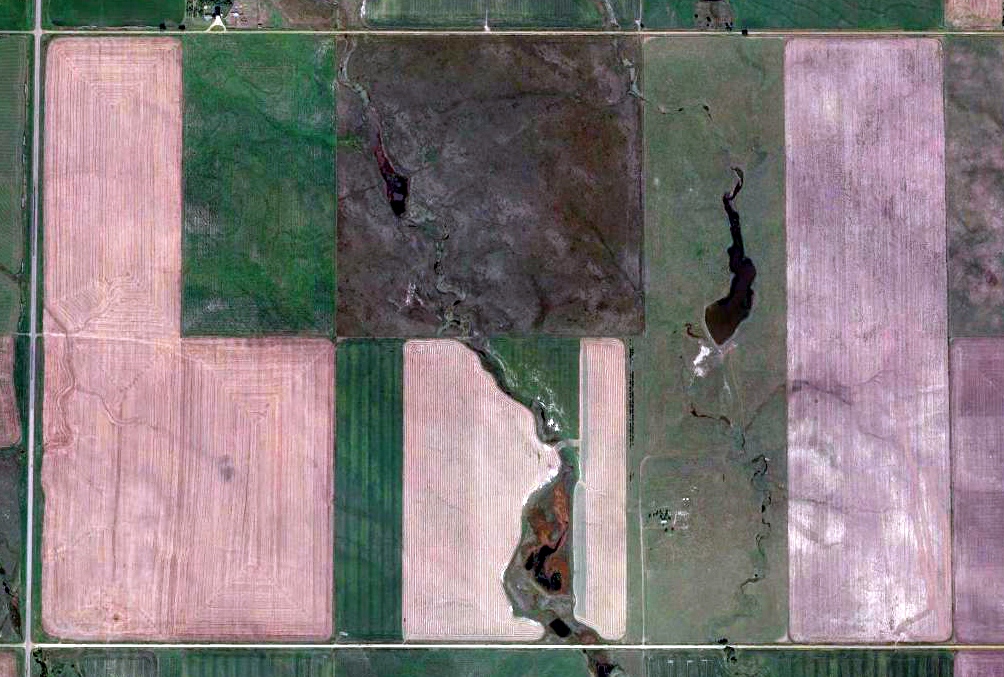
A 2014 aerial photo did not show any recognizable trace of the former Eulberg Airfield.
Thanks to Jonathan Westerling for pointing out this airfield.
____________________________________________________
Mission Sioux Airport (0V6), Mission, SD
43.307, -100.629 (Southeast of Rapid City, SD)

Mission Sioux Airport, as depicted on the 1969 USGS topo map.
Photo of the airport while in use has not been located.
Mission Sioux Airport was evidently established at some point in 1969,
as it was not yet depicted on the November 1969 Sioux City Sectional Chart
nor listed in the 1969 Airman's Information Guide (according to Jonathan Westerling).
The earliest depiction which has been located of Mission Sioux Airport was on the 1969 USGS topo map.
It depicted the field as having a single paved northwest/southeast runway, with a ramp on the southwest side.
There were no buildings depicted on the airport.
The 1971 Airman's information Guide (courtesy of Jonathan Westerling) described Mission Sioux Airport as having a 3,200' paved Runway 11/29.

The 1974 Flight Handbook (courtesy of Jonathan Westerling) depicted Mission Sioux Airport as having a 3,200' paved Runway 11/29.
The 1976 AOPA Airports USA directory (courtesy of Jonathan Westerling) described Mission Sioux Airport as having a 3,200' asphalt Runway 11/29.
The 1984 Sky Prints Atlas (courtesy of Jonathan Westerling) described Mission Sioux Airport as having a 3,200' asphalt Runway 11/29.
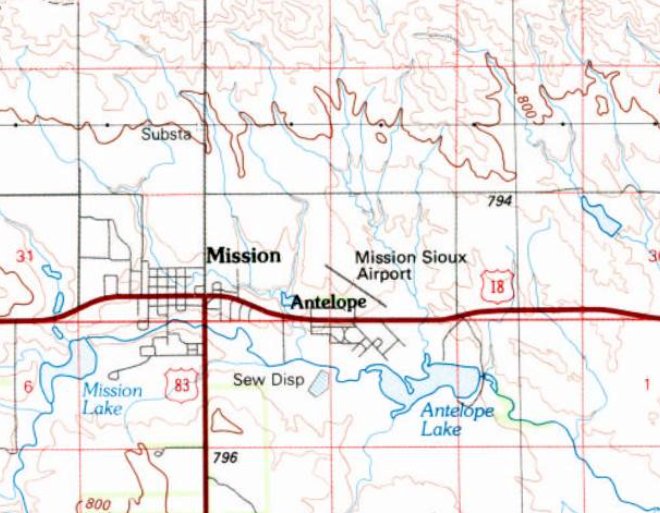
The 1982 USGS topo map depicted Mission Sioux Airport as having a single paved northwest/southeast runway.
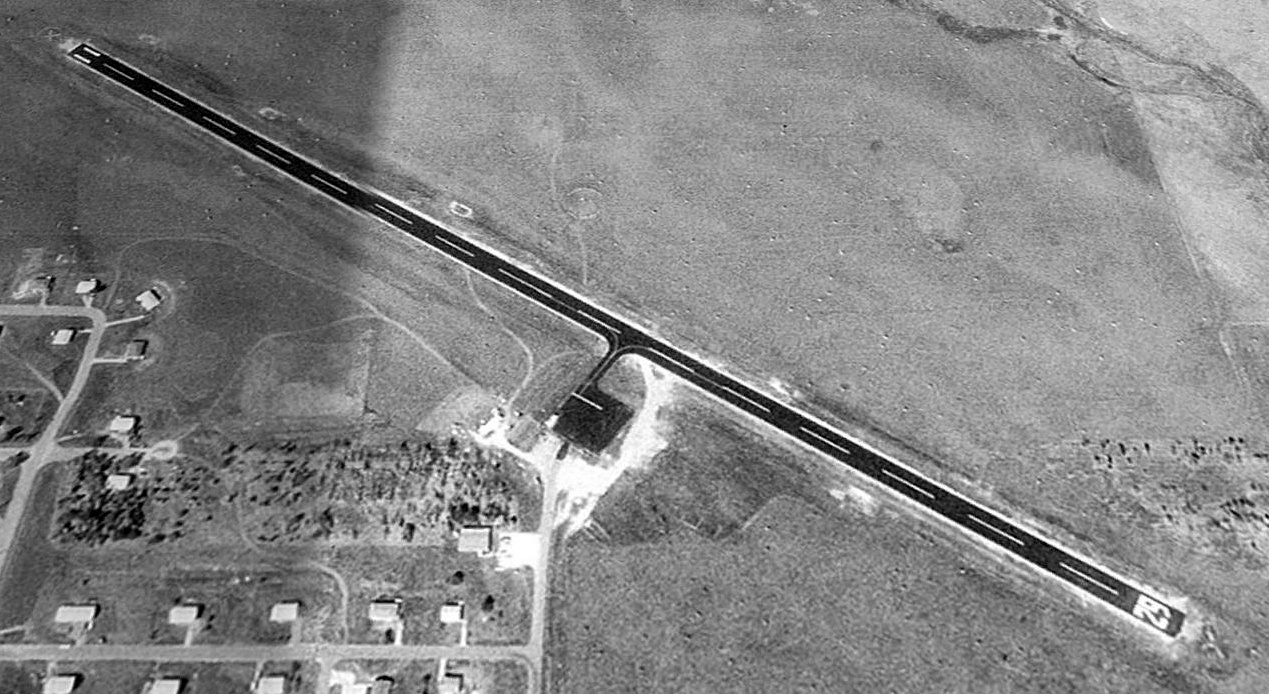
The earliest photo which has been located of Mission Sioux Airport was on a 1997 aerial view looking north.
It depicted the field as having a single asphalt Runway 11/29, with an asphalt ramp on the southwest side.
There were no buildings depicted on the airport.
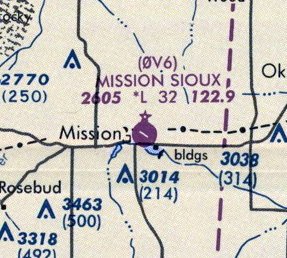
The last aeronautical chart depiction which has been located of Mission Sioux Airport was on the 2005 SD Aeronautical Chart (courtesy of Jonathan Westerling).
It depicted the field as having a single paved 3,200' northwest/southeast runway.
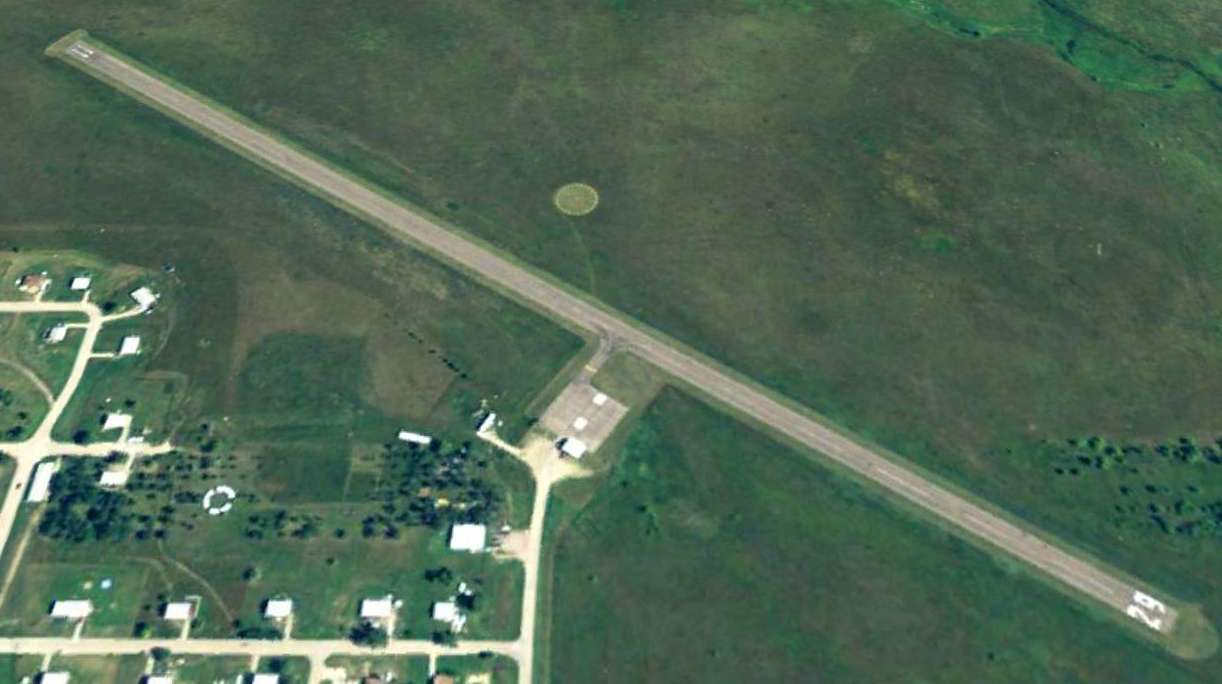
The last photo which has been located showing Mission Sioux Airport still open was a 2009 aerial view looking north.
It depicted the field as having a single asphalt Runway 11/29, with an asphalt ramp & 2 small buildings on the southwest side.
There were no aircraft visible on the field.
Jonathan Westerling reported, “SD gained a new airport on 10/7/10 with the grand opening of the Rosebud Sioux Tribal Airport (SUO)”, 12 miles east of Mission Sioux Airport.
“After the new airport opened, Mission Sioux Airport remained in operation for a transitional period
while the PAPIs at Rosebud were flight checked & a few other items are completed at the new airport, then it was closed.”

A 2016 aerial view looking north showed Mission Sioux Airport's runway pavement had deteriorated rapidly in the few years since it had been closed.
Thanks to Jonathan Westerling for pointing out this airfield.
____________________________________________________
Sturgis Municipal Airport (2nd location), Sturgis, SD
44.42, -103.4 (Northeast of Cheyenne, WY)
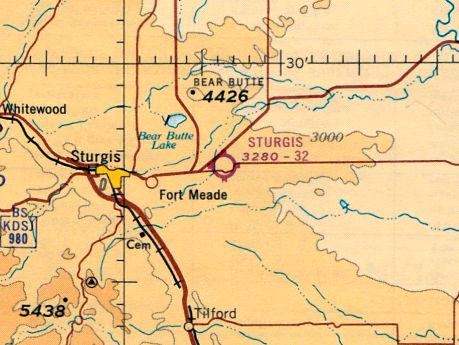
The original Sturgis Municipal Airport, as depicted on the June 1965 Rapid City Sectional Chart (courtesy of Ron Kunse).
Photo of the airport while open has not been located.
According to Norma Kraemer, this airfield replaced the original Sturgis Airport (located in town near the rodeo grounds)
when the interstate was built through its location.
This field was evidently constructed at some point between 1963-66,
as it was not yet listed among active airports in the 1963 AOPA Airport Directory (according to Chris Kennedy).
The earliest depiction of the field which has been located
was on the June 1965 Rapid City Sectional Chart (courtesy of Ron Kunse).
It depicted Sturgis as having a 3,200' unpaved runway.
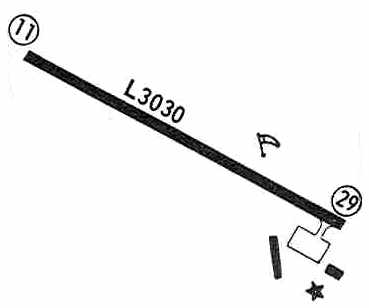
Sturgis apparently gained a paved runway at some point between 1966-71,
as the 1971 Flight Guide (courtesy of Chris Kennedy)
depicted Sturgis Municipal Airport as having a single 3,030' paved Runway 11/29,
along with a ramp at the southeast corner, around which were two buildings.

The September 1977 Cheyenne Sectional Chart (courtesy of Chris Kennedy)
depicted Sturgis as having a single 3,000' paved runway.
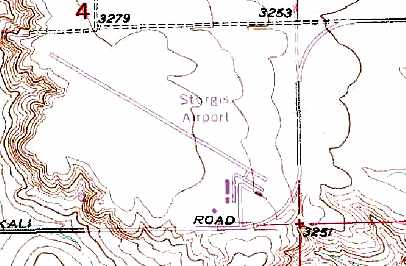
The 1991 USGS topo map depicted the Sturgis Municipal Airport as having a single 2,800' paved northwest/southeast runway,
along with several hangars on the southeast corner of the site.
According to Norma Kraemer, “The airport... I kept my plane at for some years.
It was too short a runway for high performance aircraft (anything bigger than a Bonanza)
and the impetus to quit fighting about the location was the crash of a twin carrying patients for the local VA hospital.
It hit a truck on the road adjacent to the approach end of the runway as it tried to land.
The road bed was actually about 15 feet higher than the end of the runway.
Why the pilot did not notice the truck on the road is only known to him.
He hit the water tank on the back of the truck, bounced on the runway after leaving one gear embedded in the truck,
did a go-around, and then landed on the grass adjacent to the pavement.”
A new Sturgis Municipal Airport was opened in 1994,
just across the road to the east from the existing airport.
The 2nd Sturgis Airport was presumably closed when the new airport opened.
According to Nathan Barton the construction of the new airport “was considered quite a boondoggle, for various reasons.
There were at least three ways that I could see to rebuild & extend it which would have saved a fortune.
But with 90% federal match (95% now) and with Sturgis as rich as it is, they really didn't care.”
According to Norma Kraemer, “The runway could not be expanded to the northwest because of a cliff.
The road for various reasons was not relocated.
The new location created a stir because the landowner wanted more money.”
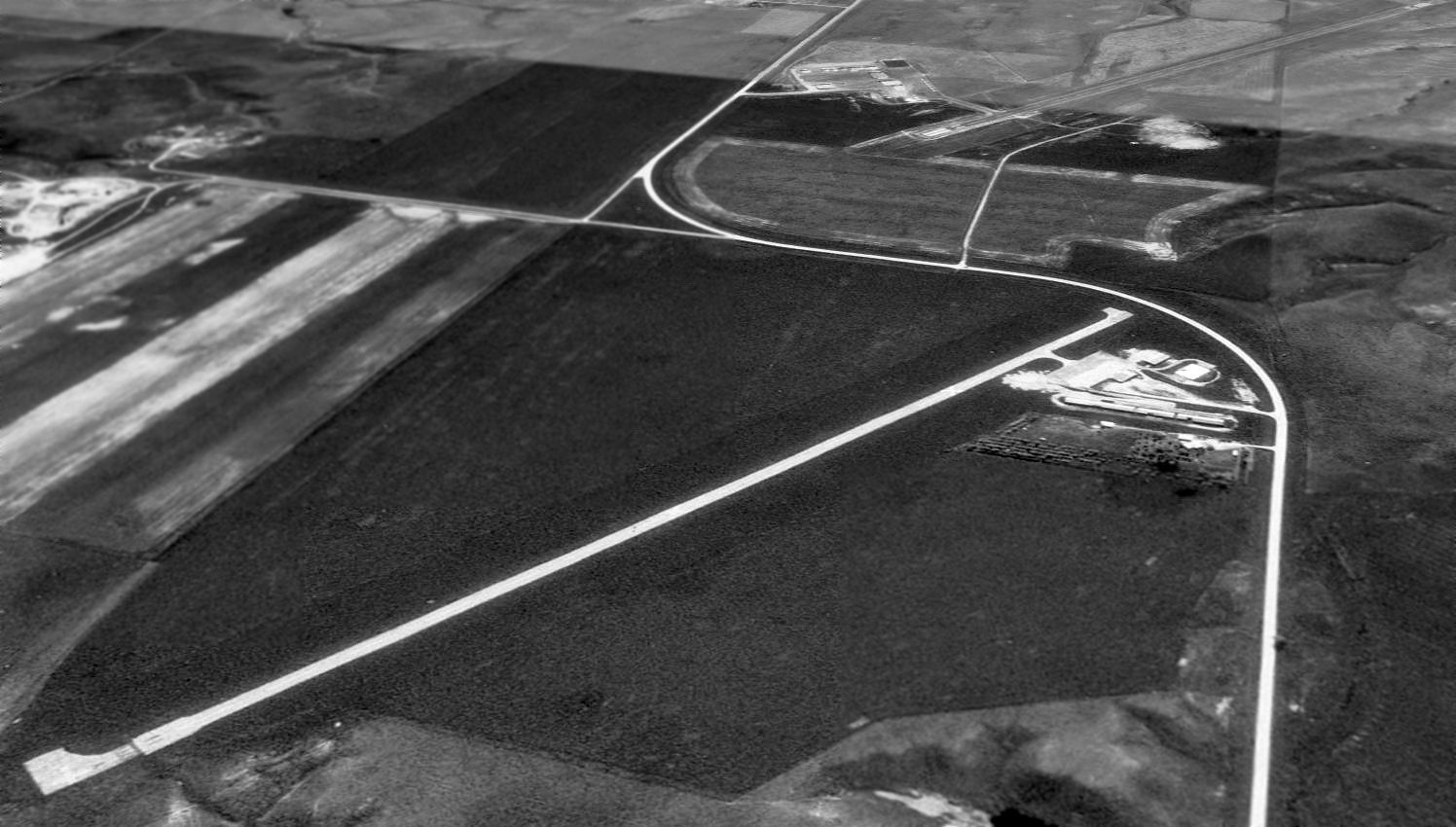
A 1995 USGS aerial view looking east depicted the unusual juxtaposition of the 2nd Sturgis Municipal Airport (in the foreground),
along with the replacement Sturgis Airport (which has an identical configuration, with an only slightly-larger runway) just across the road to the east in the background.
A 12/31/04 aerial view showed the runway pavement remained intact.
A 7/15/05 aerial view showed that the runway pavement had been removed at some point between 2004-2005.
Norma Kraemer reported in 2006, “The old airport is not a drag strip for the Sturgis rally.
It sits there pretty much as a hay field.”
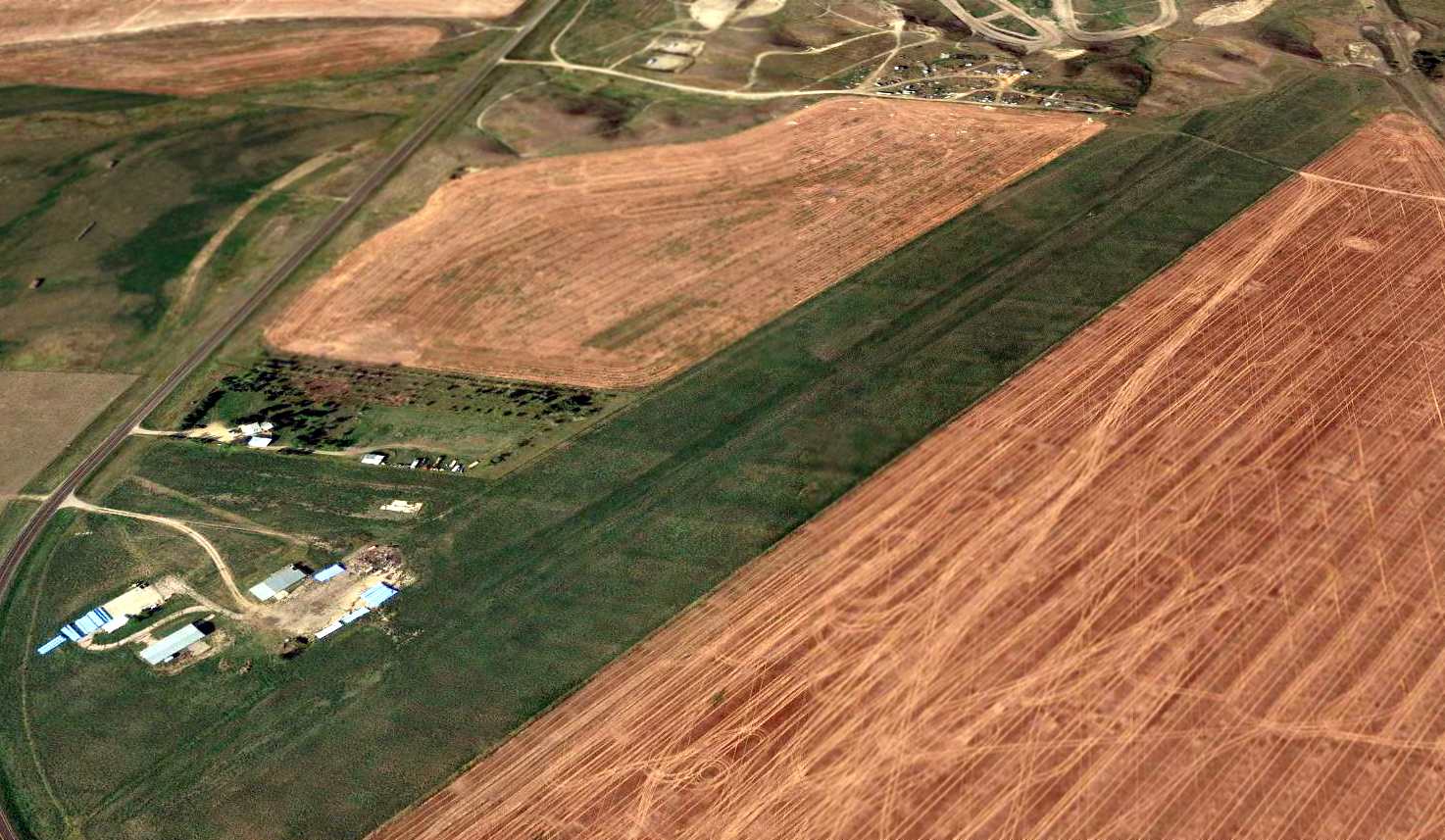
A 2015 aerial view looking west shows that the runway outline of the 2nd Sturgis Municipal Airport still remained recognizable,
and the hangars at the southeast end remained standing.
The site of the 2nd Sturgis Municipal Airport is located southwest of the intersection of 133rd Avenue & Alkali Road.
____________________________________________________
44.11, -103.27 (Northeast of Denver, CO)
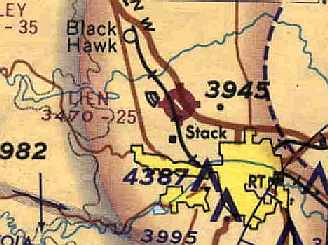
Lien Airport, as depicted on the June 1966 Rapid City Sectional Chart (courtesy of Chris Kennedy).
Nathan Barton recalled, “This was the plaything of one of the Lien Sons.
Pete Lien & Sons Inc. was established by 'Granpa' Peter Lien & his two sons [Chuck & Bruce] both WW2 vets, just after the war.
The airport was built primarily for Bruce's use,
but was opened for public general aviation use to provide for 'some' business justification for the field.”
Lein Airport was evidently established at some point between 1963-66,
as it was not listed among active airfields in the 1963 AOPA Airport Directory (according to Chris Kennedy).
The earliest depiction of Lien Airport which has been located
was on the June 1966 Rapid City Sectional Chart (courtesy of Chris Kennedy).
It depicted Lien as having a single 2,500' paved runway.

The 1971 Flight Guide (courtesy of Chris Kennedy)
depicted Lien Airport as having a single 2,630' paved Runway 16/34,
with taxiways on the northwest side of the field leading to two buildings (hangars?).

An April 5, 1972 aerial view taken at 6,000' AGL (courtesy of Paul Harwig of Fugro Horizons)
depicted Lien as having a single paved north/south runway,
with a few small buildings on the northwest & northeast sides of the field,
and 2 light single-engine aircraft on the northeast side.
The status of Lien had changed to that of a private field at some point between 1971-76,
as that is how it was listed in the 1976 AOPA Airport Directory (courtesy of Chris Kennedy).
The runway configuration was described as a single 2,630' asphalt Runway 16/34.
Lien Airport was listed in the "Low use airports" section of the 1980 Flight Guide (according to Chris Kennedy).
An NTSB report described a fatal crash in 1985 of a Cessna 320 that went off the end of the runway of at Lien Field.
According to Brad Wills, “The aircraft went across Deadwood Avenue.
The aircraft was owned by Horizons Inc. in Rapid City, which does airborne mapping.”
According to Norma Kraemer, “The Pete Lien strip was too short for even light aircraft depending on the density altitude.
I had trouble getting out of there with a Cessna 172 with an underpowered Continental engine.
I talked to the Liens & they often had to land at Rapid City Regional
because they could not put an instrument landing system in the narrow confines of the valley it was located in.
For a while an aerial mapping company based their plane there until they crashed on takeoff
and wound up in the adjacent Chevrolet dealer parking lot, killing the photographer but not the pilot.
It was NEVER competition for Rapid City Regional.
It was strictly a convenience for the Liens.”
Lien Airport was evidently closed (for reasons unknown) at some point between 1985-92,
as it was no longer depicted on the March 1992 Cheyenne Sectional Chart Sectional Chart (according to Timothy Aanerud).
According to Nathan Barton, “It was abandoned for a combination of things:
one, Bruce moved to aircraft that needed more runway,
and there was no way to lengthen the field because of land ownership, and still meet FAA rules.
Second, it was viewed as 'unfair' competition by Rapid City Regional,
which is a city-owned/operated commercial & general aviation airport,
and the Lien Airport was used as a pawn in some political negotiations.
The gophers also didn't help matters, once regular maintenance was no longer done.”

The 1998 USGS aerial photo clearly depicted Lien Airport
as having closed-runway "X" symbols on both ends of the runway.
The airport was otherwise intact.
Nathan Barton reported in 2005, “The Liens have their corporate offices in that building on the northwest corner.
They also own the quarry to the northwest, with a lime plant & other support
(the quarry to the west & southwest is another company's - once the South Dakota State Cement Plant).
The piece of land the airfield sits on is zoned & laid out for a small industrial park,
but will require extensive grading to permit this use,
since the airfield sits on top of a steep bank dropping down to the old (and long mined out) creek to the west.
About 350,000 CY of material needs to be cut to produce a usable site,
which is surprisingly (and very definitely a coincidence) about the same amount of gypsum
which can be mined from the site & sold to the cement plant.
That is waiting for number of factors, but should happen in 4-5 years.
This will completely wipe out the old airfield.”
Nathan Barton continued, “However, the saga of the Lien Airfield will probably NOT end there.
The quarry to the northwest stretches across an entire section of land to the northwest, and is nearly depleted.
So is the quarry to the south, which will eliminate that highwall on the photos to the west of the old airfield.
The crushing plant & lime plant will remain where they are,
fed limestone from a new quarry two miles west by a very long overland conveyor.
However, the rest of the quarry will be converted to a large industrial & multipurpose park,
which will feature a jet-capable airfield down the center from northwest to southeast.
This will support both industrial activities & the people who fly into the Black Hills each year
to attend the Sturgis motorcycle rally & visit the tourist attractions of the Black Hills the other 50 weeks a year.
I am aware of this as I was the environmental engineer for Pete Lien & Sons for six years,
and did the calculations on the work for preparing the site & the mining of gypsum myself.”

A 2013 aerial view looking southwest showed the former Lien Airport runway remained intact though deteriorated.
The site of Lien Airport is located southwest of the intersection of Deadwood Avenue & Universal Drive.
____________________________________________________
Newell Airport (9V0), Newell, SD
44.72, -103.41 (Southwest of Rapid City, SD)
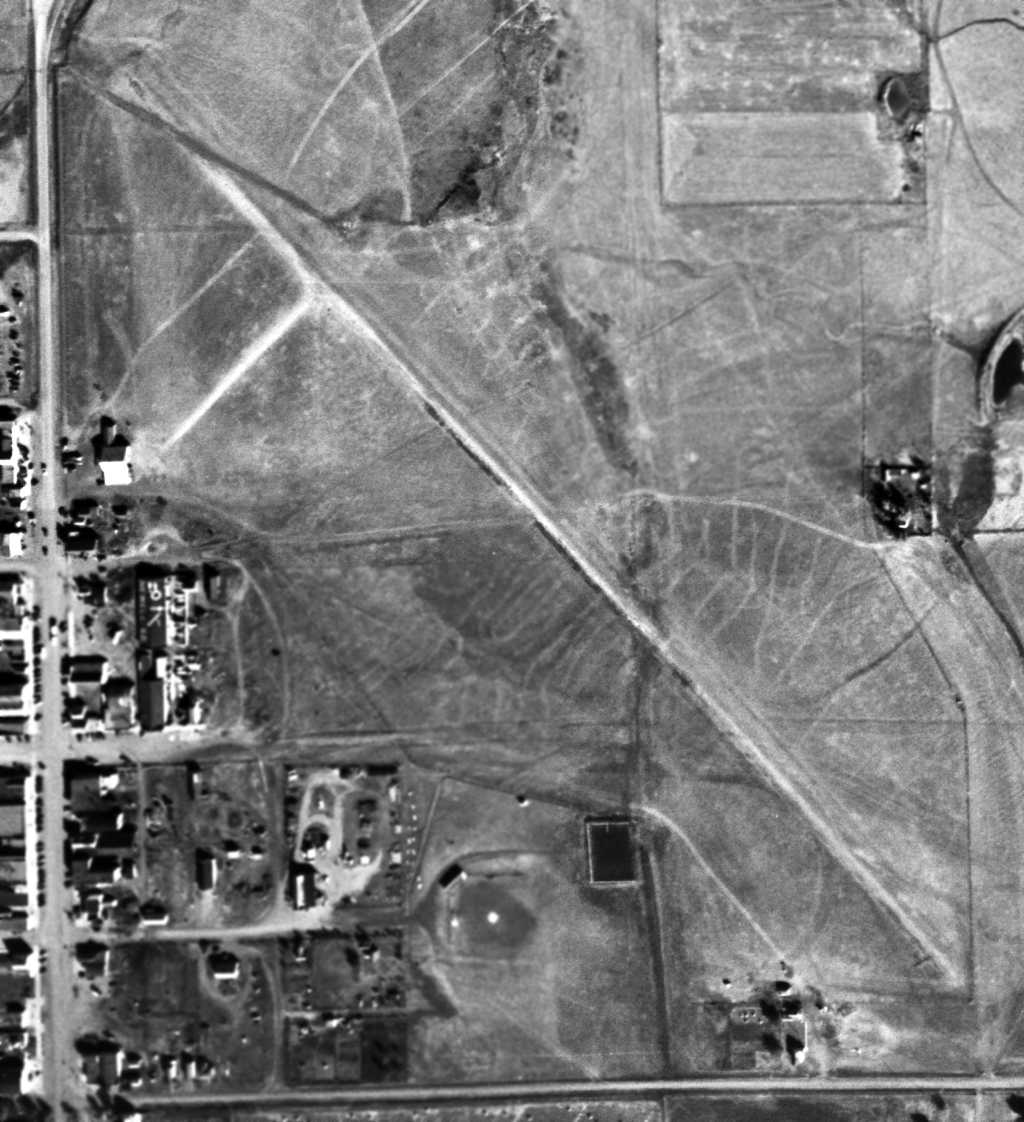
Newell Airport, as depicted on a 10/11/48 USGS aerial view.
According to Norma Kraemer, “The Newell Airport was actually the first airport designed in the Black Hills in 1911.
Newell was a designed town by the Bureau of Reclamation with the Belle Fourche irrigation project.
When the town was designed, the airport was on the east side of what was to supposed to be the railroad yard next to main street.
The railroad never came quite into town, ending on the south side of town.
Therefore, the land originally allotted to the railroad was also used for the airport.”
The Newell Airport may have ceased operations during WW2,
as it was not depicted at all on the 1944 Rapid City Sectional Chart (according to Chris Kennedy)
nor listed in the 1945 AAF Airfield Directory (courtesy of Scott Murdock).
The earliest depiction of Newell Airport which has been located was a 10/11/48 USGS aerial photo.
It depicted Newell as having a northwest/southeast runway, with one small building along the west side.

The earliest aeronautical chart depiction of Newell Airport which has been located
was on the November 1948 Rapid City Sectional Chart (courtesy of Chris Kennedy).
It depicted Newell as having a 3,000' unpaved runway.

The earliest topo map depiction which has been located of Newell Airport depicted “Airport” as having a single paved northwest/southeast runway with a few small buildings on the west side.
The March 1958 Rapid City Sectional Chart (courtesy of Chris Kennedy) depicted Newell Airport as having a 2,700' unpaved runway.
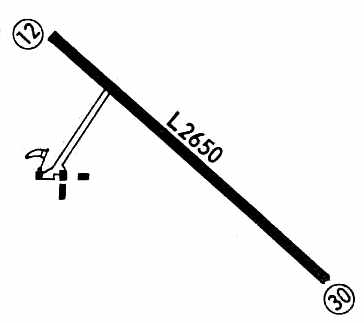
Newell Airport apparently gained a paved runway at some point between 1958-71,
as the 1971 Flight Guide (courtesy of Chris Kennedy) depicted the field as having a single 2,660' paved Runway 12/30,
with a taxiway leading to group of four buildings on the west side of the field.
The 1976 AOPA Airport Directory (courtesy of Chris Kennedy)
described Newell as offering flight instruction, rentals, hangars, tie-downs, repairs, and fuel.
Newell Airport was depicted in the same fashion on the 1980 Flight Guide (courtesy of Chris Kennedy)
as its depiction in the 1971 Flight Guide.
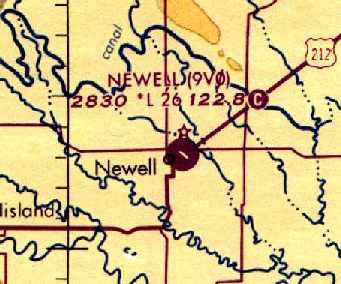
Newell Airport, as depicted on the 1993 Billings Sectional Chart (courtesy of Timothy Aanerud).
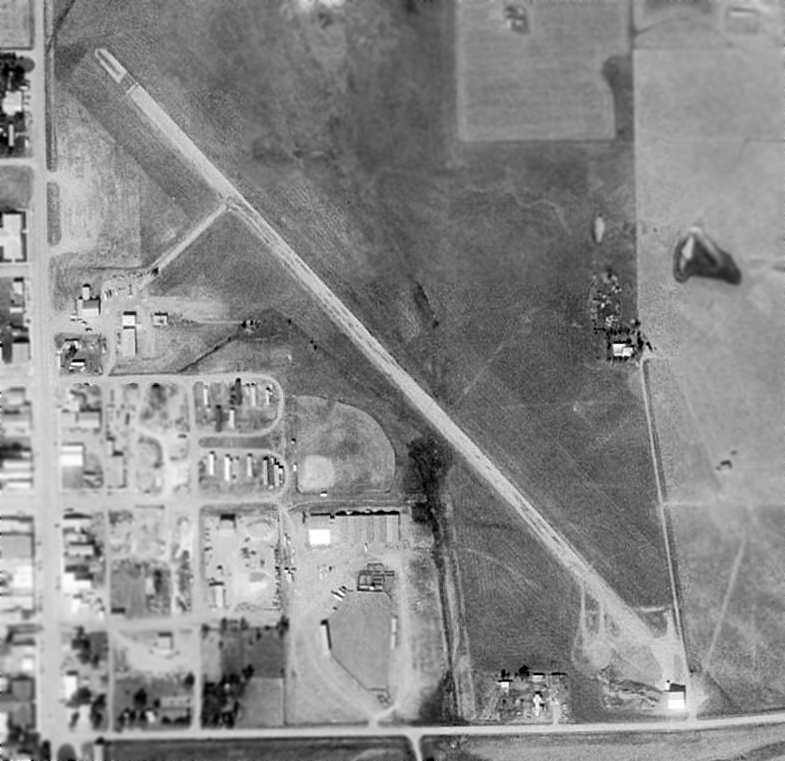
From the 1997 USGS aerial photo, it is not obvious whether or not the airfield was still active.
The runway & all of the airfield buildings still remained intact, so it may have still been open at this point.
According to Norma Kraemer, “If planes had not gotten more advanced than the Curtiss pushers & Wright Flyers of the era
the airport that was designed would be here today.
Unfortunately, the airport had a few flaws. The south end was higher than most of the runway.
Because of that on your landing approach it seemed like you never were going to touch down
because the ground was going down about the same rate as your descent.
Eventually, someone built a gas station at the north end of the runway
that looked like someone would crash into it if they had to go around.
There was also a senior citizens' apartment building built on the west side of the runway
and those people started to worry someone was going to land on them.
The runway was short, so the light twins that would come in to get their radios repaired (they had a nice radio shop for years)
finally convinced the radio guy to move his shop to Spearfish's Black Hills Airport.
In talking with the city administrator he reported they closed the airport
because the cost of liability insurance got too high.
I enjoyed going there for lunch. You could park your plane & walk one block to the diner on main street.
Of course, everyone in the diner would whisper to one another 'who's that'
when they didn’t see a car or truck parked out front.
They seemed to think we were aliens from another planet.
No one notices small airplanes landing because the power is cut back.”
Newell Airport was closed at some point between 1993-98,
as it was no longer depicted on the 1998 World Aeronautical Chart.
The site of Newell Airport is located east of the intersection of Route 212 & 4th Street.
____________________________________________________
Black Hills Army Airfield, Igloo, SD
43.18, -103.85 (Southwest of Rapid City, SD)
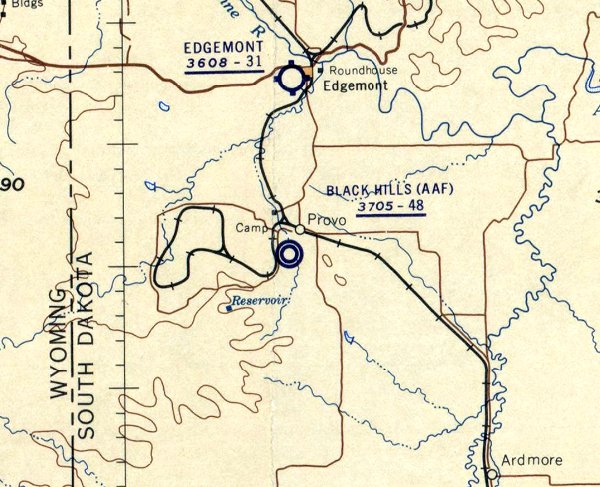
Black Hills AAF, as depicted in the November 1958 Casper Sectional Chart.
Photo of the airfield while in use has not been located.
The 21,095 acre Black Hills Army Depot was built in 1942,
intended for the long-term storage & maintenance of a wide variety of Army ammunition.
An airfield was built to support the depot operations, evidently in 1958,
as it was was not yet depicted on the May 1958 Casper Sectional Chart.
The earliest depiction which has been located of Black Hills AAF was on the November 1958 Casper Sectional Chart.
It depicted Black Hills AAF as having a 4,800' unpaved runway.
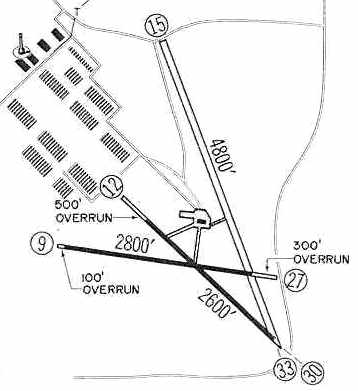
The 1960 Jeppesen Airway Manual (courtesy of Chris Kennedy) depicted Black Hills AAF as having a single 4,800' unpaved Runway 15/30,
and 2 paved runways (2,800' Runway 9/27 & 2,600' Runway 12/30).
Taxiways led to a small ramp in the center of the field, with a single small building (a hangar?).
The Aerodromes table on the April 1965 Casper Sectional Chart (courtesy of Chris Kennedy)
described Black Hills AAF as having 3 unpaved runways, with the longest being 4,800'.
The pavement had been presumably been removed from the 2 paved runways at some point between 1960-65?
The Black Hills Army Depot was closed in 1967.
The majority of the depot property was sold to the local government, which has resold various parcels to a variety of private parties.

A 10/7/74 USGS aerial view depicted Black Hills AAF after its closure, having 2 paved runways, a 3rd unpaved runway,
and a taxiway leading to a small ramp on the north side with a single small building (a hangar?).

The Black Hills airfield was depicted as "Landing Strip" on the 1982 USGS topo map.
As of 1992, the airfield area was owned by Fall River Properties.
According to Nathan Barton, “The old Black Hills Ordnance Depot airfield was dropped from the list [closed]
because the asphalt has so deteriorated that you'd be better off trying to land in the hayfield BESIDE the runways.
Fall River Properties actually planned to destroy the old airfield to construct a giant landfill
for disposing of sewage sludge shipped on the railroad from MN & IL,
but the state denied them a permit after a whole series of lawsuits by environmental groups.
I did the environmental assessment for the Fall River Properties project, back in the early 1990s.”

The earliest photo which has been located of the Black Hills Airfield was a 1997 USGS aerial view looking north.
It showed the 3 unpaved runways still remained intact,
as well as a helipad & two small Quonset huts to the north of the runway intersection.
The airfield was not depicted at all (even as an abandoned airfield) on recent aeronautical charts.
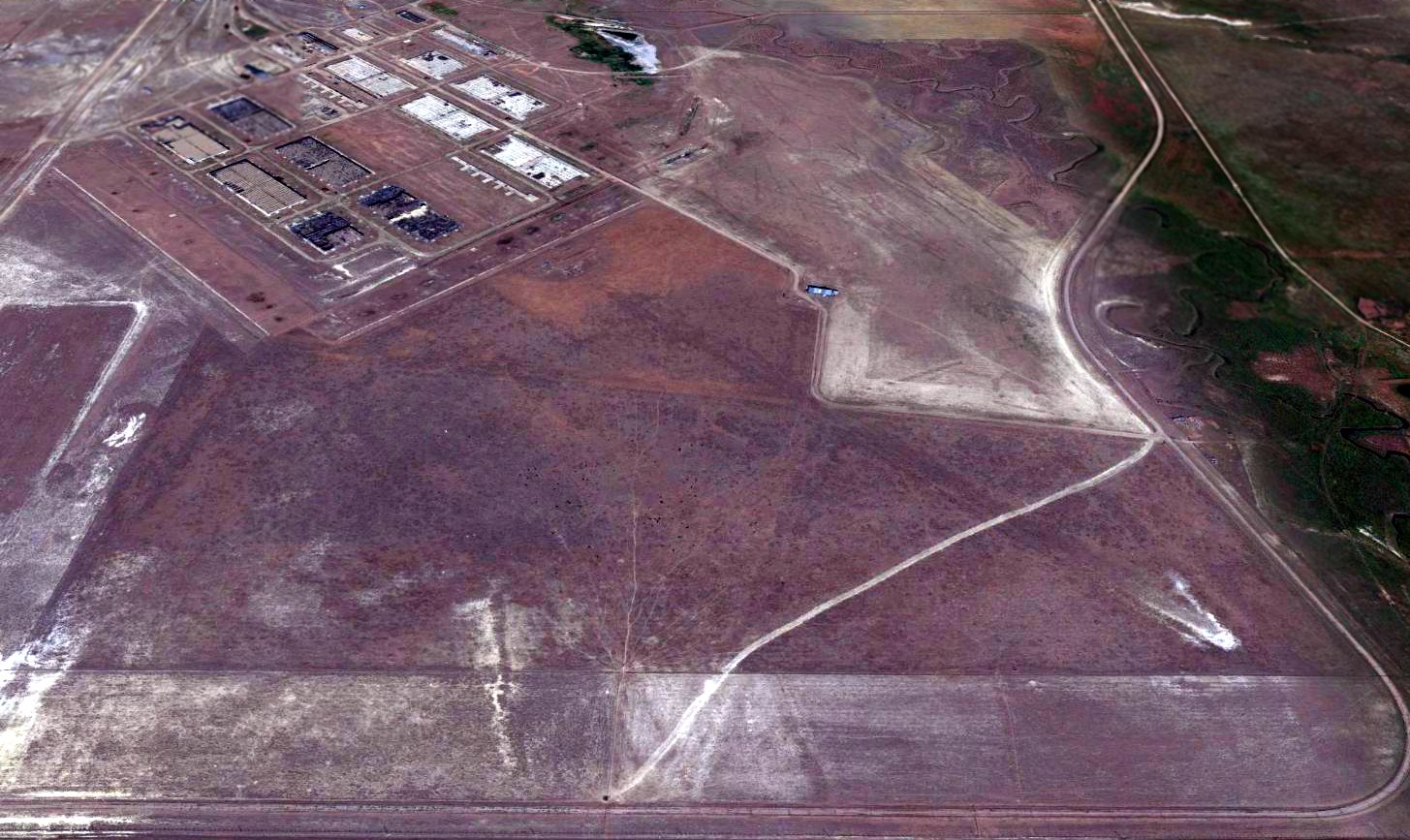
A 9/7/12 aerial view looking north showed the outline of the 3 Black Hills Airfield runways to remain barely recognizable.
Two small Quonset huts remained to the north of the runway intersection.
A 1992 Army Corps of Engineers report provides further details of Black Hills Army Depot.
____________________________________________________
Or if you prefer to contact me directly concerning a contribution (for a mailing address to send a check),
please contact me at: paulandterryfreeman@gmail.com
If you enjoy this web site, please support it with a financial contribution.
____________________________________________________
This site covers airfields in all 50 states.